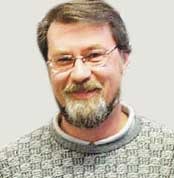Treating allergies, collodial minerals, plantar facillais
By Jonathan Evans
Herbal Information Specialist /Business Representative for the Herbarium
Special to PRIME
Welcome to autumn! To me, this time of year is the best, even with seasonal allergies.
How can I be so upbeat when so many are suffering with stuffy heads, itchy eyes and scratchy throats and runny noses? I know the secret. No, not the abundance thing everyone is talking about (though I am familiar with that also) I know Mother Nature's secrets to living well with allergies.
As I began to tell you last month, there are a variety of products that can help allergy sufferers that are very simple and effective.
The products
Dr. Claytons, Sinus-ade is a general allergy remedy. The formula contains a variety of herbs to work as anti-inflammatory, cleansers, demulcents and immune system regulators. The combination of these plants will help relieve the acute symptoms and over time, will help to either build up your resistance to the allergens or reduce your body's overreaction. I have found the longer I used this formula, the less I needed, the longer the relief and the faster I felt better. I do not know the exact mechanism by which the formula works, but honestly, I don't care. All I know is I rarely need to use it anymore.
Another product that works well is a liquid from Buried Treasure. Aller-Ease contains a mixture of vitamins, amino acids, traditional herbs and several other nutrients. The formula is designed to inhibit the release of histamine and support immune system response. Two ingredients you may have heard about are Quercetin and bromelain. Quercetin is a bioflavonoid that inhibits the over production of histamine and helps reduce inflammation. Bromelain, which comes from the pineapple helps increase absorption of quercetin and is a very good anti-inflammatory enzyme. For best results, this product is best taken on an empty stomach or between meals.
Stinging Nettle is sometimes used for allergy relief. The herb has shown to significantly reduce mucous and nasal congestion. Interestingly, nettle root is very helpful for BPH, or Benign Prostatic Hyperplasia, and the young tender leaves have been used for food throughout history. Some people have used stinging nettle to help relieve arthritis pain. Who would have thought such a nasty, pesky weed would have so many uses? But I digress.
Homeopathic remedies have become more popular over the years, especially among people who are on several prescription medications and might have concerns about a possible interaction with herbs. Homeopathics offer some of the safest help you can find, Because the ingredients in a homeopathic product are diluted to extreme levels, the possibility of a negative side effect or interaction is just about nil.Homeopathy offers some very specific remedies such as grass pollen, tree pollen, animal hair, dander, hay fever, sinusitis, etc,. Best of all, these products can list exactly what they are used for. There is no fooling around with questions of definitions established by the FDA.
Echinacea and auto-immune diseases
By the way, for people who have been told that they should stay away from Echinacea if they have an auto-immune disease because it would over stimulate their immune systems should not believe the warning.
There is no evidence to show Echinacea will worsen the problem. That idea is purely conjecture, and speculation. The original research into Echinacea was not complete and this story continues to circulate. I have allergies, and have taken Echinacea for years. If anything, it has helped, not hurt my situation. Echinacea is an immune modulator and regulator. It will boost a slow system, but does not throw you into overdrive.
Colloidal vs trace minerals
A question came up on the radio program recently, pertaining to colloidal minerals. The caller was told that colloidal are better than trace minerals. This sounds to me like a sales pitch from some multi-level marketing firm.
Just for clarification, trace minerals are minerals that the body needs but in smaller quantities. For instance, calcium requirements are 800-1500 milligrams (mg)s but selenium is only 200 micrograms or (mcg). For reference, 1000 micrograms equal one milligram and 1000 milligrams equal one gram. Colloidal minerals are measured in parts per million and parts per billion.
To give you a comparison, suppose a paper clip is one gram. Take that paper clip and hide it in 10 football fields, There is your one part per million. One part per billion would be akin to hiding that paper clip in the state of Indiana!
The only way I can understand using colloidals and the effect they have on a person would be to compare it to a homeopathic response, meaning that, the small amount of the mineral causes the body to react as if there were enough of the mineral present. Another analogy would be like adding STP gas treatment to your fuel tank. It helps the car engine perform better, but at some point you do need to add gasoline. Your car cannot run exclusively on the STP. I look at colloidal as the STP and your regular minerals as the gasoline. Your body needs a certain amount of vitamins and minerals to function properly. I hope this helps clear up any confusion.
Plantars faciitis update
Last month I gave some remedies for plantars faciitis. Here is something else to try. Use a vibrator or hand held massage unit on the underside of the heel, then massage around the sides and up the back of your heel and up the back of the leg. About ten minutes and it will really loosen up that tendon.
Jonathan
Please send your questions on botanical remedies to Natures Rx : Jonathan Evans via e-mail at info@theherbarium.com, or by regular mail at The Herbarium, 264 Exchange Street, Chicopee, MA 01013.
